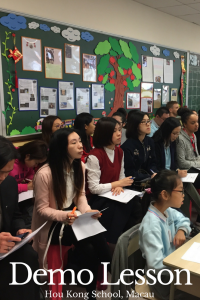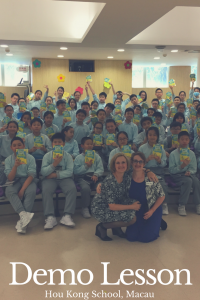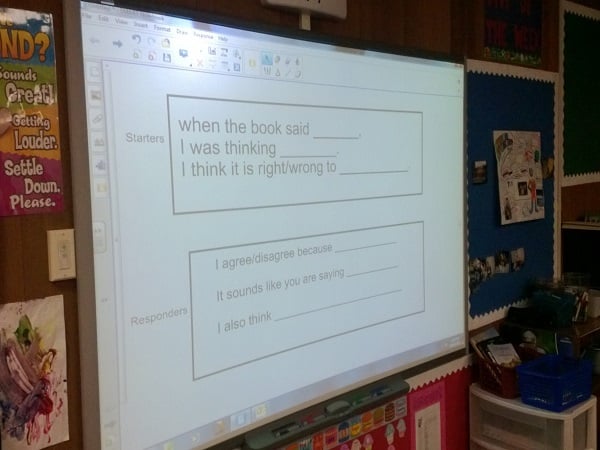Using Turn and Talk Stems Across the Globe

 Earlier this month, Bethany and I had the amazing opportunity to travel to Macau near Hong Kong to work with teachers and English Language Learners in Hou Kong Premier School to learn many of the strategies of our C. I. A. curriculum. While there, we learned the power of turn and talk stems—a major part of the Read Side by Side curriculum—to give confidence and a feeling of success to students learning the English language. How gratifying to see this approach help students across the globe!
Earlier this month, Bethany and I had the amazing opportunity to travel to Macau near Hong Kong to work with teachers and English Language Learners in Hou Kong Premier School to learn many of the strategies of our C. I. A. curriculum. While there, we learned the power of turn and talk stems—a major part of the Read Side by Side curriculum—to give confidence and a feeling of success to students learning the English language. How gratifying to see this approach help students across the globe!

Day 1
Our first day at Hou Kong was busy as we met administrators, teachers, and students and began to learn what a school day in Macau looks like. We observed three separate classrooms that day, having the opportunity to witness students practicing new vocabulary, and listening to chapter books being read out loud to them. While teachers in this building were not using the C. I. A. method yet, it was clear that their priorities matched the priorities of our program; to help students to access the texts they desire to read through the scaffolds of vocabulary development and teacher read-aloud.
In one sixth-grade classroom, we observed students listening and following along as the teacher read the book Tales of a Fourth Grade Nothing (Blume, 2007). Throughout the reading the teachers stopped often to discuss unknown words and encourage students to make predictions. Those who were more outgoing and more confident sharing their ideas raised their hand and were called on. Students less confident simply sat back and listened to the discussion of their peers. While all students were engaged in the lesson, not all of them demonstrated full participation, and therefore, not all of them practiced the oral language and comprehension strategies covered in the lesson.
Day 2

Our second day at Hou Kong, Bethany and I began to teach demonstration lessons in classrooms grades 3-9. Our goal was to show teachers how to use turn and talk stems to engage all students in oral practice. Our expectation was that all students would have a turn and talk partner, and that partners would share and respond to each other’s thinking, and that partnerships would share their thinking with the class during the whole-class share-out time. While we had seen this method work successfully in the States with English Language Learners in general education classrooms, we had yet to try it in this unique environment! Would it work?
Not only were these students learning a new language (English), we came to learn that these students were not second language learners but third language learners. In the home and community, students learn and practice Cantonese. Once they enter school, they begin learning Mandarin which differs from Cantonese in pronunciation, grammar, and lexicon. In this particular school, students also begin to learn English, a language not often spoken outside of the school walls. As one teacher reminded us, “Students are learning English as a foreign language.”
 To our relief, when we began to teach lessons using the turn and talk stems found throughout our reading program, students began to participate eagerly. While it was exciting to watch their faces light up with confidence as they began to share their thinking, it was more exciting to watch the faces of their teachers. Many were shocked to see the quietest, shyest students participating. Students who were struggling with English proudly stood and shared their thinking with the class (and the 20 plus teachers who were observing in the back of the room!).
To our relief, when we began to teach lessons using the turn and talk stems found throughout our reading program, students began to participate eagerly. While it was exciting to watch their faces light up with confidence as they began to share their thinking, it was more exciting to watch the faces of their teachers. Many were shocked to see the quietest, shyest students participating. Students who were struggling with English proudly stood and shared their thinking with the class (and the 20 plus teachers who were observing in the back of the room!).
I have to confess; there were many moments when I had to clear my throat before speaking because I felt so choked up by these amazing students. I recall one day when I was meeting with an impromptu book club group (a structure students at this school had never experienced) and I called on a boy to share his thinking. I sensed the rest of the students looking at me strangely, but continued to prompt the boy to share his thinking. He began to use the stem, “When the book said…” but his voice came out in a stutter. “When…when…when…the…the…books said…”, and despite the struggle he kept going. He finished the stem inserting his own thinking and textual evidence. The grin on his face when he finished was priceless! But the best part was when someone else in the group responded saying, “I agree with you because…” The power of turn and talk stems was so evident on this day! The scaffolds of the stems and the book club structure gave this boy the confidence and the safety to share his thinking with his teacher and his classmates.
Day 3

Another day, Bethany and I were co-teaching a lesson to 75 students in a performing arts room. In addition to these 75 students, there were 15-20 teachers watching (and a video camera)! To ensure that everyone could hear the lesson, Bethany and I were each using a microphone. The lesson explicitly taught students to ‘gather evidence to support a line of thinking’, a completely new concept to these students. Throughout the lesson, students had to turn and talk with a partner, and respond to each other’s thinking. After each turn and talk time, Bethany and I called on one or more partnerships to stand up and speak into the microphone in order to share their thinking with the group. I called on a partnership to share and could quickly tell that one partner was stronger and more confident than the other. When I asked her to stand and share her thinking she said, “I’d like my partner to share. She had a good idea and I know that she can do it.” She turned to her partner, who looked scared to death, and coaxed her to stand. She whispered in her partner’s ear, “I will help you.” The girl began to speak, very hesitantly into the microphone, “When the book said…” and her partner began to whisper the words to her in her ear. When the girl finished sharing her thinking, both Beth and I were crying. The entire room put their thumbs up to show that they agreed with her thinking.

There is power in giving students a head start in putting together their deep thinking about a book. Turn and talk stems are that head start—they get them going. But what I love is that the turn and talk stems also push them beyond what they would say on their own. How rewarding to see their strength, even in a population of children who are learning a third language; a population of students who are used to the traditional method of calling on students who raise their hand, and drilling students with worksheets and skill practice. To see the C.I.A. Approach give confidence to these children was a blessing to me. I hope this story somehow blesses you in your teaching.

Are you looking for a reading program to increase motivaiton and achievement?
We are confident the Read Side by Side Reading Program will be the right fit for your next curriculum adoption! To learn more about the program and request a sample kit, connect with on of our advisors!

Written by Sarah Collinge
Founder and President
Read Side by Side Publications, LLC.
References
Blume, J. (2007). Tales of a fourth grade nothing. New York, NY: Penguin.


.png)
